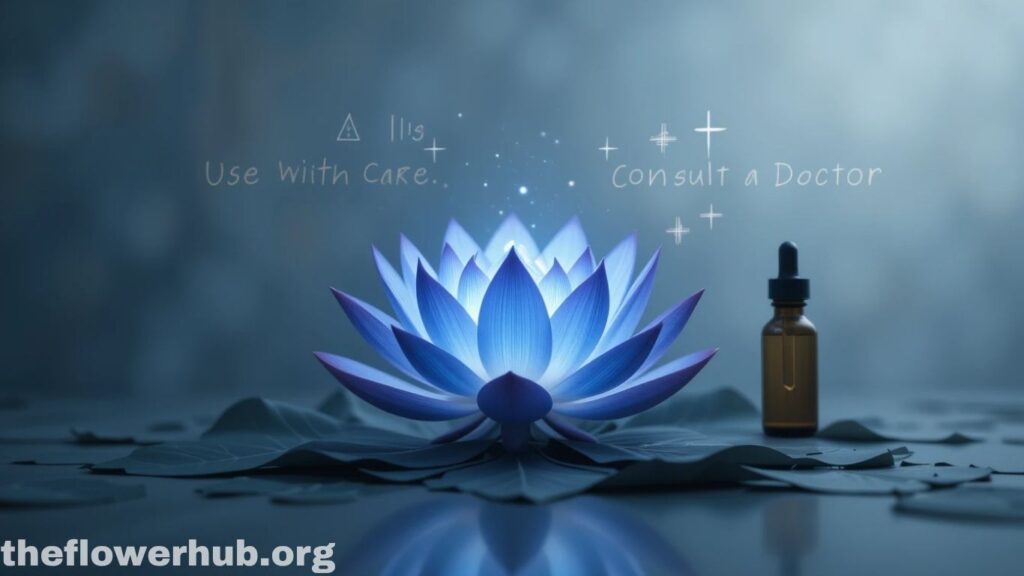The Blue Lotus Flower is not only captivating because of its striking beauty, but it has been one of the most revered and culturally significant plants of various civilizations for thousands of years. This holy water plant is not only a visual beauty, it comes with a great spiritual significance and a myriad of benefits across the physical, emotional and intellectual wellbeing spectrum. In this definitive guide, we will cover the potent benefits, symbolism, meaning, and traditional and modern uses of the Blue Lotus Flower.
Table of Contents
Quick Facts About Blue Lotus Flower
| Feature | Details |
|---|---|
| Scientific Name | Nymphaea caerulea |
| Common Names | Blue Lotus, Sacred Blue Lily, Egyptian Lotus |
| Native Region | Egypt, also grows in select regions in East Africa |
| Flower Color | Blue, purple |
| Primary Active Ingredients | Nuciferine, Apomorphine |
| History of Use | Used in religious ceremonies, medicine and perfume |
| Forms | Tea, oil, extract, tincture, dried petals |
What is the Blue Lotus Flower?

The Blue Lotus Flower (Nymphaea caerulea) known also as the Egyptian Blue Lotus or Sacred Blue Lily is a blue water lily which is found along the Nile and other locations such as the North East African country of Burundi. It was highly revered by early cultures, including the Egyptians, who believed it to be a symbol of rebirth, and often portrayed the scarab beetle in shrines, tombs, and sacred texts.
Unlike a common flower, the Blue Lotus opens and closes with the day, a process of representing a daily cycle of rebirth. This has only solidified its place as a religious icon. In addition, the flower was incorporated in ceremonial beverages and incense to evoke mediation and feelings of euphoria.
11 Amazing Health Benefits of the Blue Lotus Flower
The Blue Lotus offers more than just beauty. From the healing powers to spiritual rejuvenation, here are 11 awesome things it can do for your life:
Promotes Deep Relaxation
Blue Lotus features compounds such as nuciferine, which is known to promote muscle relaxation and relieve stress. It’s something that many people take in teas and tinctures to unwind from a busy day.
Enhances Sleep Quality
Traditionally used as a gentle sedative, it may support better sleep patterns. The soothing benefits assist those who are suffering from insomnia or high anxiety.
Natural Aphrodisiac
Long revered as a love and fertility symbol, the flower heightens the sensual experience by stimulating bloodflow, and even reduce inhibitions.
Alleviates Anxiety and Stress
Its calming effects alleviate symptoms of anxiety and nervous tension. Apomorphine stimulates dopamine receptors and induces a state of well-being.
Supports Mental Clarity
Blue Lotus also has been found in studies to offer benefits related to enhanced focus and concentration, which is why it is such a popular choice among professionals and students.
Elevates Mood
The blossom has been known to act as a dopamine-releaser, which many find leads to good feelings and emotional improvement.
Spiritual Awakening
In meditation, and as part of religious ceremony, the flower acts to get the third eye to open, and also to promote a sense of well being, spirituality, and oneness with the universe.
Pain Relief
It has some mild pain relieving properties, which might be useful for mild discomfort, such as headaches or menstrual pain.
Anti-Inflammatory Effects
The flowers contain compounds that work as anti inflammatory agents, reducing inflammation and aiding in recovery.
Skin Health Support
Its antioxidants properties may help to improve skin complexion and hydrate your face, which can be beneficial post-acne.
Antioxidant Boost
High in antioxidants, the flower fights free radicals and boosts immunity.
Significance Through Civilizations
Ancient Egypt
The Blue Lotus was a symbol of the sun, creation and rebirth. It was frequently depicted in the hands of gods and pharaohs. The sunflower’s blooming pattern on a daily basis represented the path of the sun as well as the soul.
Hinduism & Buddhism
In Eastern cultures, the Blue Lotus is the embodiment of purity, wisdom and enlightenment. In Buddhism, it symbolizes the triumph of the spirit over the senses, as well as death of the ego and futility of pleasure, alluding to a soul that is progressing towards eternal enlightenment.
Modern Spiritual Movements
The flower is often used in rituals and meditations by contemporary spiritual healers to inspire healing and inner tranquility.
Traditional and Modern Uses
Tea and Beverages
One of the most popular ways to ingest Blue Lotus today is in its tea form. It is said to have a floral flavor with moderate bitterness and calming properties.
Aromatherapy and Oils
Blue Lotus essential oils are used in aromatherapy as an anxiety reliever so remember to enjoy your Lotus experiences with extreme care. The aroma is profoundly relaxing and can be found in many high-end parfumes.
Tinctures and Extracts
A tincture of the flower can be added to water or juice and ingested for gently elevating and de-stressing.
Devotional and Religious Practices
From fumigations to sacred baths, the flower continues to serve in spiritual ceremonies across the globe.
Skincare Products
Blue Lotus extracts are added to creams of serums to give the skin a fresh feel and bring about an anti-aging effect.
Safe Use of the Blue Lotus Flower
Is Blue Lotus safe? Blue Lotus is considered safe for healthy adults when consumed in moderation. But it’s important to understand proper usage.
- Teas: Infuse the dried petals with boiling water for 5–10 minutes.
- Oils: Massage into skin, or use in diffusers.
- Tinctures: Use the manufacturer’s suggested dosage.
Do not take in conjunction with alcohol or prescription sedatives as it may potentiate their effects.
Side Effects & Precautions
Although the Blue Lotus Flower is naturally occurring, it’s not without its risks:

- Sedation: Large amounts may also result in extreme drowsiness.
- Interactions: May interact with antidepressants and anti-anxiety drugs.
- Allergies: Rare but can occur. Patch test should be done before using topically.
- Pregnancy and breast-feeding: Not enough is known about the use of cranesbill during pregnancy and breast-feeding.
As always, it’s best to check in with a healthcare professional before implementing new supplements in your routine.
FAQs
What is the spiritual symbolism of the Blue Lotus Flower?
It is the symbol of enlightenment, birth, and spiritual awakening . It is frequently associated with enlightenment and peace of mind.
Blue Lotus smoke or Blue Lotus drink?
Yes, you can smoke it for its medicinal effects or make tea from it. However, moderation is key.
Is Blue Lotus psychoactive?
It is thought to be mildly psychoactive, providing benefical emotional and relaxation effects without the hallucinogenic result.
Is the Blue Lotus Flower legal? Can you buy it online?
In the vast majority of countries, including the U.S., it is legal to purchase and consume. It is forbidden in some places, though, so be sure to check the local statutes.
Is Blue Lotus like being high?
It can create a mild sense of euphoria and deep relaxation, but it is not a drug in the usual sense.
Conclusion
The Blue Lotus Flower is not only an exotic looking flower, but is also a spiritual and natural remedy, heart opener, and key to the discovery of one’s own truth. From its sedative effects to its presence in rituals and skin care, this age-old flower imbues life even now. By knowing all of its angles — from its long-standing roots to modern life applications, you can safely and effectively experience its full potential.
Whether looking for peace of mind, craving a more numerous life, or aspiring a deeper spiritual connection, the Lotus opens the pathway.
